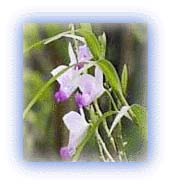Arunachal himalayas
General Info
· Kangto Massif
· Namcha Barwa Massif
People
Problems

![]()
| Flora and fauna The Arunachal Himalayas receive heavy rainfall from the monsoon clouds. Two mighty rivers -- the Kameng and the Dihang (Brahmaputra) -- flow in the region. It is covered with thick Amazonian rain forests. These forests present a picture of perpetual gloom as the sunlight does not reach the ground -- a typical feature of rain forests. This also accounts for the fantastic biodiversity of the Arunachal Himalayas, as the forests are home to a great number of plant and animals species. |
Arunachal Himalayas is virgin territory. (Download Realplayer) |
The Arunachal forests are a largely untapped source of medicinal herbs with seemingly magical properties. They remain destined to be used in tomorrow's world for creating drugs to treat diseases -- both the ones present today and those yet to come.
 |
| Orchids of Arunachal Credit: Karamjeet Singh |
The Orchid Research Center at Tipi, with the co-operation of the WWF and the Indian Army, is trying to preserve around 500 species of orchids.
Another reason why Arunachal Pradesh remains unexplored are its leeches. They are longer than the normal leeches found elsewhere in the mountains and average 4-5 inches in length. They thrive up to an altitude of 12,000 ft above sea level.
The Tiger leech of Tawang is one of the more famous varieties of leeches. So called because of its coloration, the Tiger leech drops onto travelers from trees and bushes to find a vein near the surface to which it latches on. Their saliva contains hirudin, an important anticoagulant widely used in medicine. They can ingest up to three times their body weight in blood and then hide away for up to two months to digest their "food". Leeches have been known to be used in traditional medicine for bloodletting purposes. In the recent past, they have been used in delicate brain surgery in order to relieve congestion from a particular area without side-effects.
The interesting feature of the ecosystem in Arunachal is the altitude gradient. Flora and fauna, as we know, are greatly affected by altitude. A wide variety of vegetation is found in the region -- from tropical to alpine -- within a distance of a mere 200 km. The reason for this are the varying altitudes in the region, ranging from 500 m above sea level at the floor of the Brahmaputra valley to 7,000 m at the top of the Great Eastern Himalayas. The change in the vegetation at many places is dramatic due to the steep altitude gradient. Tropical evergreen forests flourishing in the lower regions give way to upper mixed forests where species like Ban oak, rhododendrons, and Silver fir thrive.
All rights reserved